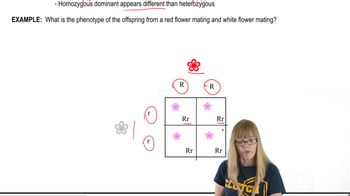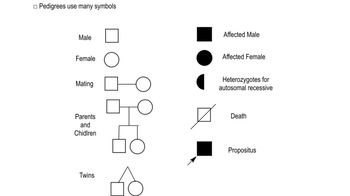Table of contents
- 1. Introduction to Genetics51m
- 2. Mendel's Laws of Inheritance3h 37m
- 3. Extensions to Mendelian Inheritance2h 41m
- 4. Genetic Mapping and Linkage2h 28m
- 5. Genetics of Bacteria and Viruses1h 21m
- 6. Chromosomal Variation1h 48m
- 7. DNA and Chromosome Structure56m
- 8. DNA Replication1h 10m
- 9. Mitosis and Meiosis1h 34m
- 10. Transcription1h 0m
- 11. Translation58m
- 12. Gene Regulation in Prokaryotes1h 19m
- 13. Gene Regulation in Eukaryotes44m
- 14. Genetic Control of Development44m
- 15. Genomes and Genomics1h 50m
- 16. Transposable Elements47m
- 17. Mutation, Repair, and Recombination1h 6m
- 18. Molecular Genetic Tools19m
- 19. Cancer Genetics29m
- 20. Quantitative Genetics1h 26m
- 21. Population Genetics50m
- 22. Evolutionary Genetics29m
2. Mendel's Laws of Inheritance
Pedigrees
Problem 52a
Textbook Question
In humans, the ability to bend the thumb back beyond vertical is called hitchhiker's thumb and is dominant to the inability to do so (OMIM 274200; see Problem 41). Also, the presence of attached earlobes is recessive to unattached earlobes (OMIM 128900).
Using all available and willing members of your family, or members of another family if yours is not easily accessible, trace the transmission of both traits in a pedigree. Use allelic symbols H and h for the thumb and E and e for earlobes, and identify the genotypes for each family member as completely as possible. Bring the pedigree back to share with your group.
 Verified step by step guidance
Verified step by step guidance1
<Identify the traits and their dominance: Hitchhiker's thumb (H) is dominant over non-hitchhiker's thumb (h), and unattached earlobes (E) are dominant over attached earlobes (e).>
<Gather information from family members about their phenotypes for both traits: whether they have hitchhiker's thumb and whether they have attached or unattached earlobes.>
<Create a pedigree chart: Start with the oldest generation at the top and work down to the youngest, using standard symbols (squares for males, circles for females, shading to indicate the presence of a trait).>
<Assign genotypes based on phenotypes: For example, if a person has hitchhiker's thumb, they could be either HH or Hh; if they have attached earlobes, they must be ee.>
<Use the information from the pedigree to deduce unknown genotypes: Consider the inheritance patterns and use the known genotypes of parents to infer the possible genotypes of offspring.>
Recommended similar problem, with video answer:
 Verified Solution
Verified SolutionThis video solution was recommended by our tutors as helpful for the problem above
Video duration:
4mPlay a video:
Was this helpful?
Key Concepts
Here are the essential concepts you must grasp in order to answer the question correctly.
Dominant and Recessive Traits
In genetics, traits can be classified as dominant or recessive based on their expression in an organism. A dominant trait, represented by a capital letter (e.g., H for hitchhiker's thumb), will manifest in the phenotype even if only one copy of the allele is present. In contrast, a recessive trait, denoted by a lowercase letter (e.g., e for attached earlobes), requires two copies of the allele to be expressed. Understanding this distinction is crucial for predicting inheritance patterns in a pedigree.
Recommended video:
Guided course

Variations on Dominance
Pedigree Analysis
A pedigree is a diagram that depicts the genetic relationships and inheritance patterns within a family over generations. It uses standardized symbols to represent individuals and their traits, allowing for the visualization of how traits are passed down. Analyzing a pedigree helps identify the genotypes of family members based on their phenotypes and the known dominance of certain traits, which is essential for understanding genetic inheritance.
Recommended video:
Guided course

Pedigree Flowchart
Genotype and Phenotype
The genotype refers to the genetic makeup of an individual, specifically the alleles they carry for a particular trait, while the phenotype is the observable expression of that genotype. For example, an individual with the genotype HH or Hh will exhibit the hitchhiker's thumb phenotype, whereas only the genotype hh will result in the non-hitchhiker's thumb phenotype. Distinguishing between these concepts is vital for accurately determining the genetic traits of family members in a pedigree.
Recommended video:
Guided course

Gamete Genotypes

 2:48m
2:48mWatch next
Master Pedigree Symbols with a bite sized video explanation from Kylia Goodner
Start learning



